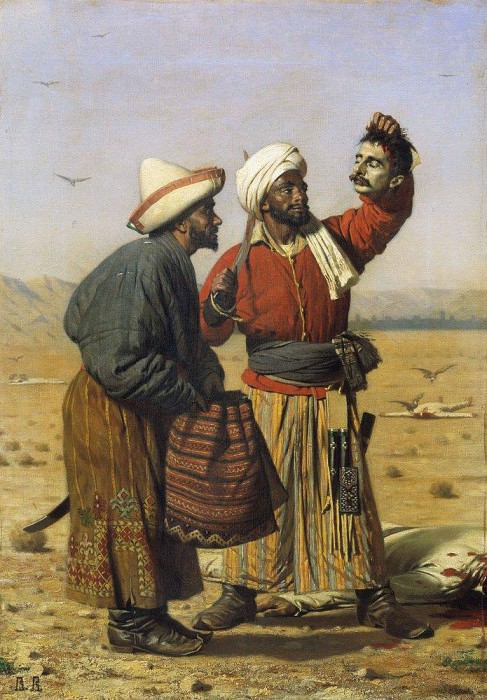After good luck. 1868 Vasily Vereshchagin (1842-1904)
Vasily Vereshchagin – After good luck. 1868
Edit attribution
Download full size: 695×1000 px (0,1 Mb)
Painter: Vasily Vereshchagin
Vereshchagin was twice in Central Asia, which inspired him to paint the Turkestan series of paintings. The artist was struck and shocked by everything in the East: from the beauty of human hearts and amazing things created by human hands to the cruelty and indifference of the surrounding world. In many of Vereshchagin’s paintings one can see the elegance of architecture and, as a contrast to this, the poor clothes on the characters. Turkestan series of art connoisseurs received ambiguously.
Description of Vasily Vereshchagin’s painting "After Luck"
Vereshchagin was twice in Central Asia, which inspired him to paint the Turkestan series of paintings. The artist was struck and shocked by everything in the East: from the beauty of human hearts and amazing things created by human hands to the cruelty and indifference of the surrounding world.
In many of Vereshchagin’s paintings one can see the elegance of architecture and, as a contrast to this, the poor clothes on the characters.
Turkestan series of art connoisseurs received ambiguously. The familiar Vereshchagin landscapes were replaced by bloody military brutality, which abounded in the new subject compositions. Heads carved from the shoulders, taken as trophies of victory won, have a horrifying effect on every observer.
"After Luck" is a vivid example of Vereshchagin’s Turkestan war theme, which depicts the soulless thugs of Asia assessing a white man’s head, separated, from a bloody slaughtered body.
Benois, the famous critic and art historian, evaluating the artist’s work in general and the painting "After Luck" in particular, agreed with those who were outraged by Americanism and the "bad painting" of a man who "cannot be called an artist". However, he also characterizes Vereshchagin as a selfless, tireless and dedicated person.
For many, Vereshchagin’s art of war and remained incomprehensible. The color palette was striking, but at the same time, it took on the appearance of colored patches against the alienity of the presented paintings.
Kramskoi was one of the few who admired Vereshchagin’s pictures and called the artist a "great Russian" who raised the Russian spirit and made hearts beat with pride. He not only openly admired the work of the artist, but also considered the success of the Turkestan series to be enormous, calling for it to be made public domain and in every way defending the grandiose talent of the author.
Кому понравилось
Пожалуйста, подождите
На эту операцию может потребоваться несколько секунд.
Информация появится в новом окне,
если открытие новых окон не запрещено в настройках вашего браузера.
You need to login
Для работы с коллекциями – пожалуйста, войдите в аккаунт (open in new window).




















You cannot comment Why?
In the background, the landscape stretches out with distant hills and a hazy sky. Several birds, possibly scavengers like crows or vultures, circle overhead. In the middle ground, there are further signs of conflict and death: more birds are seen flying near what appears to be fallen bodies or casualties amidst the sparse vegetation. The foreground, where the two men stand, is littered with rocks and sand, and a body lying on the ground further emphasizes the grim scene.
The title, After Good Luck, is highly ironic given the brutal imagery. It suggests that this act of violence, perhaps a battle or raid, has been successful for these men, likely resulting in spoils or a victory that they are celebrating in this gruesome manner. The painting starkly portrays the barbarity and ruthlessness of warfare or tribal conflict, without glorifying it but rather depicting it with a disturbing realism. The detached head and the presence of scavengers underscore the finality of death and the primal nature of the struggle for survival or dominance. The overall atmosphere is one of desolation, violence, and a chilling display of conquest.